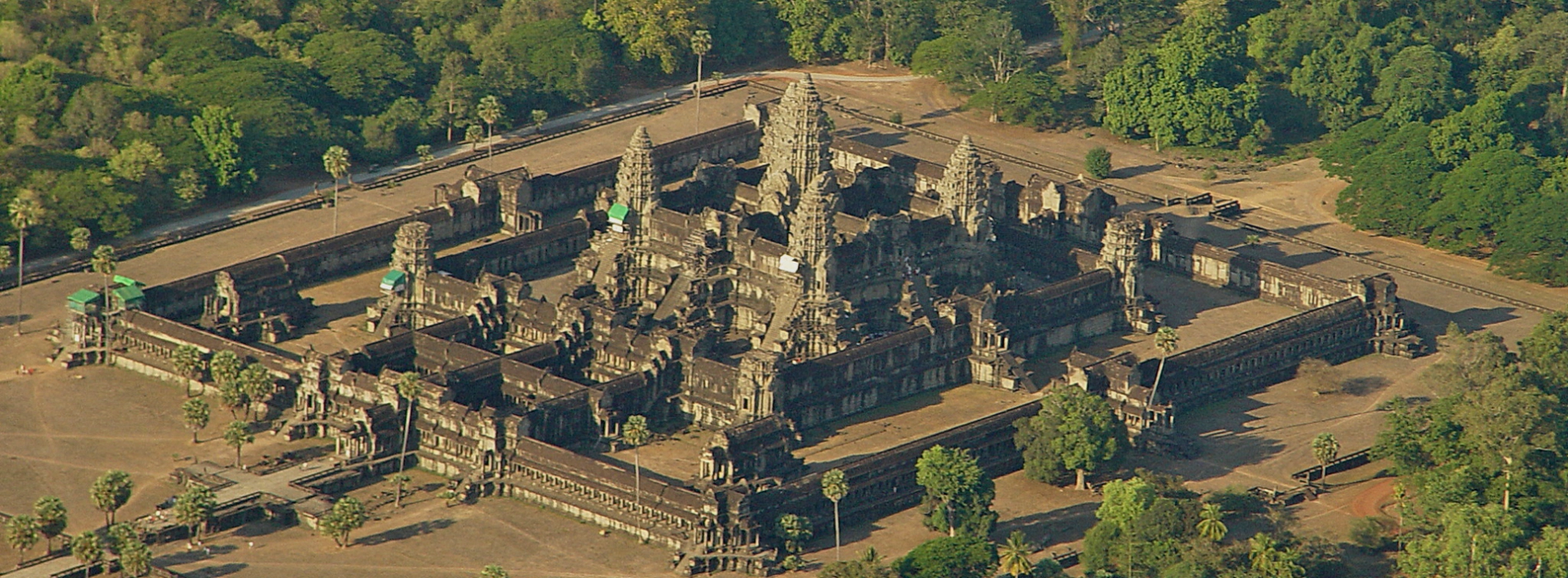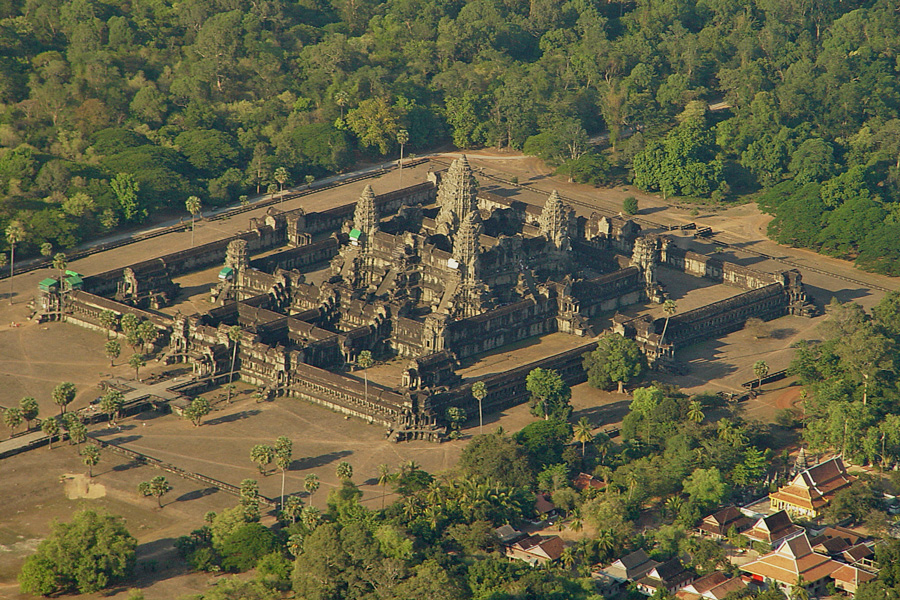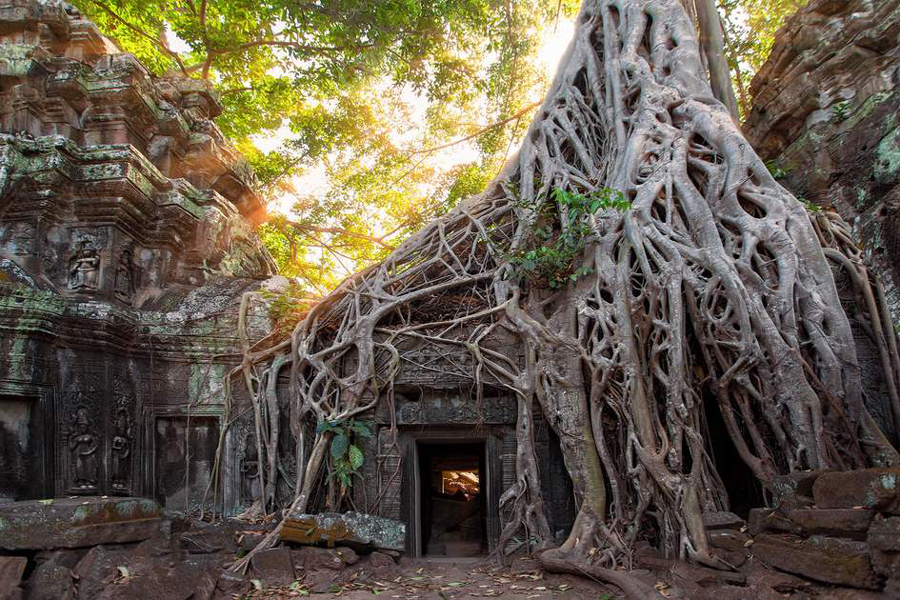
Angkor Wat, a remarkable temple complex in Cambodia, was constructed during the early 12th century. The credit for its construction is generally attributed to King Suryavarman II, who ruled the Khmer Empire from 1113 to 1150. The specific timeframe for the construction of Angkor Wat is estimated to be around 1113 to 1145 AD.

This architectural masterpiece, initially dedicated to the Hindu god Vishnu before transforming into a Buddhist site, stands as a testament to ancient Khmer craftsmanship and engineering. The age and historical significance of Angkor Wat contribute to its recognition as a UNESCO World Heritage Site, drawing visitors from around the world to marvel at its cultural and architectural splendor.

Angkor Wat holds the distinction of being the largest religious monument in the world. Covering an expansive area of approximately 162.6 hectares (400 acres), this colossal temple complex in Cambodia is a testament to the architectural and artistic achievements of the Khmer Empire. Its grand scale, intricate design, and historical significance make Angkor Wat a prominent symbol of Cambodia and a must-visit destination for those interested in history, culture, and ancient architecture. The vastness of Angkor Wat contributes to its unique status as the largest religious monument globally, attracting millions of visitors each year to explore its rich heritage and mystical charm.
.jpg)
Angkor Wat is renowned not only for its grandeur but also for its unique orientation. Unlike most Hindu temples, which are typically east-facing, Angkor Wat is aligned to the west. This distinctive feature has sparked scholarly debates and interpretations. Some suggest that the westward orientation may symbolize a connection to Vishnu, as west-facing temples are associated with this deity in certain Hindu traditions. Others propose that the alignment might signify a symbolic setting sun, representing the cycle of life and death. Additionally, there are theories linking the westward orientation to the temple's role as a funerary monument. Regardless of the interpretation, Angkor Wat's deviation from the typical eastward orientation adds an intriguing layer to its mystique, inviting contemplation about the cultural and religious nuances embedded in its architectural design.
The breathtaking bas-reliefs adorning the outer walls of Angkor Wat stand as an extraordinary testament to the artistic brilliance of the Khmer civilization. These intricate carvings, etched into the sandstone, vividly narrate mythological tales, historical episodes, and religious stories. Notably, the depiction of the Churning of the Ocean of Milk, with gods and demons engaged in a celestial tug of war, captures the essence of Hindu mythology. Scenes from the Ramayana and Mahabharata unfold with meticulous detail, while heavenly and hellish realms emphasize the consequences of moral conduct in the afterlife.

Apsaras, celestial dancers, grace the walls in elegant poses, showcasing the Khmer mastery of sculptural art. In a harmonious blend of religious devotion and everyday life, the bas-reliefs also portray the ruler, King Suryavarman II, engaged in ceremonial activities. As visitors traverse the gallery, the narrative unfolds, providing a captivating journey through time and culture in the heart of Angkor Wat, the largest religious monument in the world.
Angkor Wat, with its evocative name, encapsulates the grandeur of the ancient Khmer Empire. The term "Angkor" pays homage to the majestic city that served as the empire's capital, while "Wat" signifies the sacred temple within its walls. Together, "Angkor Wat" resonates as the iconic "City of Temples." This monumental complex, a harmonious blend of Hindu and Buddhist influences, stands as a testament to the architectural brilliance and spiritual devotion of the Khmer civilization.

Angkor Wat stands as the undisputed jewel in Cambodia's cultural crown, playing a pivotal role in drawing an impressive influx of foreign tourists. As one of the most iconic and well-preserved temple complexes in the world, Angkor Wat singlehandedly attracts over 50% or more of Cambodia's foreign visitors. Its intricate architecture, captivating bas-reliefs, and cultural significance make it a must-visit destination for travelers seeking a glimpse into the country's rich history. The temple's allure is not confined to its archaeological magnificence; it also symbolizes the resilience and cultural identity of Cambodia. The sheer scale and architectural brilliance of Angkor Wat make it a beacon for tourists, contributing significantly to Cambodia's tourism industry and offering a captivating gateway to the country's ancient past.
Despite its fame, size and historical importance, Angkor Wat isn't considered among the New Seven Wonders of the World. It lost out when the official voting result was announced on July 7, 2007.
Indeed, Angkor Wat was initially constructed as a Hindu temple. Commissioned by King Suryavarman II in the early 12th century, the temple was dedicated to the Hindu god Vishnu. Its architectural design, intricate bas-reliefs, and symbolic elements, such as the central tower representing Mount Meru, reflected the Hindu cosmological beliefs prevalent during that era. It was only later, in the 13th century, that Angkor Wat underwent a transformation into a Buddhist temple, mirroring the shift in religious practices and influences in the region. The transition from Hinduism to Buddhism marked a significant phase in Angkor Wat's history, underscoring the cultural evolution that took place within the Khmer civilization.
Read more: Angkor Tour 5 Days: Authentic Angkor

The Angkor Wat complex is more than just the iconic temple itself; it encompasses a vast archaeological site with various structures and features of historical and cultural significance. Surrounding the main temple are remnants of an extensive urban and administrative complex, reflecting the grandeur of the ancient Khmer Empire. The complex includes several other temples, such as the Bayon Temple, famous for its towering stone faces, and Ta Prohm, known for being partially engulfed by the jungle.
Additionally, there are libraries, galleries, and reservoirs within the complex, each contributing to the overall architectural and cultural richness of the site. The expansive grounds also feature intricate bas-reliefs that depict mythological and historical scenes, providing visitors with a comprehensive insight into the artistic and religious achievements of the Khmer civilization. The entirety of the Angkor Archaeological Park, where Angkor Wat is located, boasts a diverse array of structures, making it a captivating destination for those interested in exploring the multifaceted history of Cambodia.
The famous Hollywood movie Lara Croft: Tomb Raider was filmed in Angkor temple Ta Prohm. Paramount was charged USD 10000 per day to shoot at the location. Fun Fact - Angelina Jolie's first adopted son Maddox was from an orphanage in Cambodia.
You cannot enter the temple complex without maintaining a proper dress code. Visitors need to wear long pants to cover their knees and shirts covering their shoulders. And Skirts, Shorts, Tank Tops are not allowed inside the temple premises.
We hope that 10+ Interesting Facts about Angkor Wat Cambodia will provide you with more useful information about Angkor Wat as well as your wonderful upcoming trips! If you have any questions about the trip, please don't hesitate to reach out to Asia King Travel for prompt and comprehensive assistance. We hope your journey to Angkor Wat is both enjoyable and enriching!
Read more: Angkor Trekking Tour 3 Days: Jungle Trek & Temple Discovery